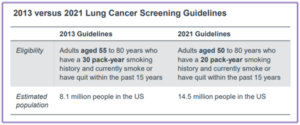Lung cancer is one of the deadliest cancers in the United States, more so than breast, colon and prostate cancers combined.
In 2022, the American Cancer Society predicts a staggering 131,180 deaths due to lung cancer, however, it also predicts that with more widespread screening, early detection could save a potential 30,000 to 60,000 lives.
Updated screening guidelines were recommended by the U.S. Preventive Services Task Force (USPSTF) last year and are now newly supported by the Centers for Medicare & Medicaid Services (CMS).
The new guidelines aim to make screenings more widely available to high risk individuals and those in rural settings and lower socioeconomic standings who often miss out on preventative medical screenings and healthcare.
One of our thoracic surgeons and lung cancer specialists, Dr. Rachel Medbery, is excited about these new recommendations as she says earlier detection is the key to improving survival rates for lung cancer patients.
“Successful treatment and results are often only possible when lung cancer is caught early,” says Dr. Medbery. “Lung cancer symptoms can be subtle and hard to detect, so screening is essential and sometimes the only tool we have for diagnosis.”
“Being able to reach more people who might not typically get tested and provide them a swifter diagnosis and care is great news.”
Under the new recommendations, lung cancer screenings should be made available to:
- Those ages 50 years and older instead of previously starting at 55 years old
- Smokers with a 20-year/pack-a-day history as opposed to those with a 30-year history
- Thousands of independent diagnostic centers across the country located in more rural and also lower-income areas
Here is an historic snapshot of how far lung cancer screening guidelines have already come:
Lung cancer symptoms may include persistent coughing, or coughing up blood, chest pain, wheezing or shortness of breath, general fatigue and weight loss. Screenings are conducted via low-dose computed tomography (LDCT) which is similar to a CT scan. A diagnosis is typically made with a surgical biopsy of the questionable lung tissue.
Once a diagnosis is confirmed, getting immediate treatment is essential for the most favorable outcome and chance for survival. CTVS offers minimally-invasive and robotic-assisted surgeries to treat lung cancer by removing dangerous nodules at their very earliest stage.
For questions about any of our cardiac, vascular, or thoracic services, please visit ctvstexas.com or call us at (512) 459-8753 to schedule an appointment with one of our board-certified specialists.
Don’t forget to follow us on Facebook and Instagram and check our blog for regular updates.


